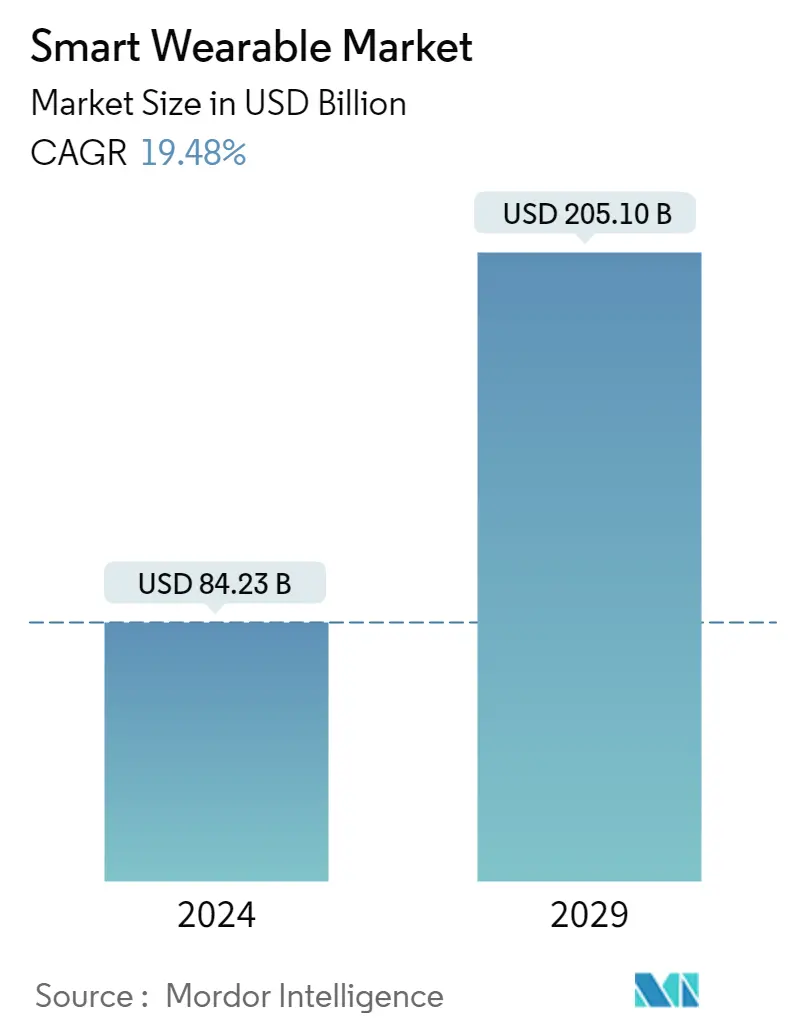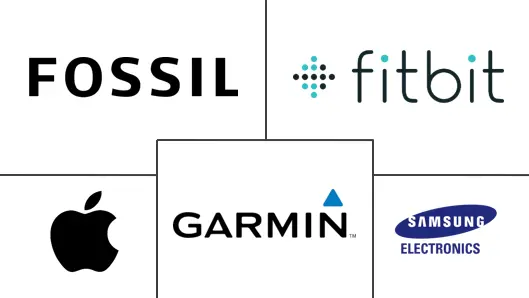Market Size of Smart Wearable Industry

| Study Period | 2021 - 2029 |
| Market Size (2024) | USD 84.23 Billion |
| Market Size (2029) | USD 205.10 Billion |
| CAGR (2024 - 2029) | 19.48 % |
| Fastest Growing Market | Asia Pacific |
| Largest Market | North America |
Major Players
*Disclaimer: Major Players sorted in no particular order |
Smart Wearables Market Analysis
The Smart Wearable Market size is estimated at USD 84.23 billion in 2024, and is expected to reach USD 205.10 billion by 2029, growing at a CAGR of 19.48% during the forecast period (2024-2029).
Research advancements have led to increased innovation in recent years and are instrumental in driving the demand for the wearable market. It also led to new product categories like smart fabrics and hearables, which incorporate high-end technology and design in daily living. Lately, the focus is to provide an aesthetic design to devices to attract customers.
- Wearable technology, an emerging trend, integrates electronics into daily activities and addresses the changing lifestyles with the ability to wear on any body part. Factors such as the ability to connect to the internet and data exchange options between a network and a device are leading to the wearable technology trend.
- Wearables have gained significant traction owing to the boom in the fitness trend across consumers. According to Cisco Systems, connected wearable devices are expected to increase from 593 million in 2018 to 1,105 million this year. The smartwatch category is experiencing a rise, owing to additional features, like the brand that suits the everyday lifestyle. Strong brands, such as Apple and Fossil, are keeping the pricing consistent with the price bands of traditional watches to maintain their revenues. With Google's WearOS, many other premium watchmakers, such as TAG and Armani, have entered the segment.
- The rising penetration rates of urbanization in various parts of the world have driven the demand for advanced, aesthetically appealing products to better serve consumers' requirements, such as multiple features in one device and time schedules. Moreover, the vast millennial population across the globe was quick to adopt smartwatches, owing to the increased spending ability on their regular work hours tracking and luxury standards.
- Hearables are gaining traction with the increasing acceptance of smart assistants. Companies like Bragi, Google, Apple, Jabra, Samsung, and Sony have been actively contributing to the growth of this segment.
- The COVID-19 outbreak and the lockdown restrictions across the world have affected industrial activities around the globe. The electronics industry is hit severely with a significant influence on its supply chain and production facilities. Production reached a standstill in China and Taiwan during February and March, influencing various OEMs worldwide.
Smart Wearables Industry Segmentation
Wearable technology study tracks the various types of products currently being adopted, such as smartwatches, head-mounted displays, smart clothing, ear-worn, fitness trackers, body-worn camera, exoskeletons, and medical devices.
The Smart Wearable Market is segmented by product (smartwatch, head-mounted display, smart clothing, ear-worn, fitness tracker, body-worn camera, exoskeleton, and medical devices) and geography (North America, Europe, Asia Pacific, Latin America, and Middle East and Africa).
The market sizes and forecasts are in terms of value (USD million) for all the above segments.
| By Product | |
| Smartwatches | |
| Head-mounted Displays | |
| Smart Clothing | |
| Ear Worn | |
| Fitness Trackers | |
| Body-worn Camera | |
| Exoskeleton | |
| Medical Devices |
| By Geography | |||||||
| |||||||
| |||||||
| |||||||
| Latin America | |||||||
| Middle East and Africa |
Smart Wearable Market Size Summary
The smart wearables market is experiencing significant growth, driven by technological advancements and increased consumer demand for innovative and aesthetically appealing devices. This market encompasses a wide range of products, including smart fabrics, hearables, and smartwatches, which integrate high-end technology into daily life. The trend towards wearable technology is fueled by the ability to connect to the internet and exchange data, making these devices an integral part of modern lifestyles. The fitness boom has further propelled the popularity of wearables, with consumers increasingly adopting smartwatches for their convenience and style. Major brands like Apple, Fossil, and Google are actively expanding their offerings, catering to the diverse needs of consumers, particularly the millennial demographic.
The Asia-Pacific region is poised for substantial growth in the smart wearable market, supported by a burgeoning electronics industry and rising disposable incomes. Countries like China and India are at the forefront, with China being a major manufacturing hub for these devices. The Indian government's initiatives to boost local manufacturing are also contributing to market expansion. The competitive landscape is marked by rapid innovation and strategic partnerships, as companies like U&i and Vuzix Corporation continue to introduce new products and technologies. This dynamic environment is expected to sustain the market's growth trajectory, with smart wearables becoming increasingly integral to consumers' daily lives.
Smart Wearable Market Size - Table of Contents
-
1. MARKET DYNAMICS
-
1.1 Market Drivers
-
1.1.1 Incremental Technological Advancements Aiding the Market Growth
-
-
1.2 Market Restraints
-
1.2.1 High Cost and Data Security Concerns
-
-
-
2. MARKET SEGMENTATION
-
2.1 By Product
-
2.1.1 Smartwatches
-
2.1.2 Head-mounted Displays
-
2.1.3 Smart Clothing
-
2.1.4 Ear Worn
-
2.1.5 Fitness Trackers
-
2.1.6 Body-worn Camera
-
2.1.7 Exoskeleton
-
2.1.8 Medical Devices
-
-
2.2 By Geography
-
2.2.1 North America
-
2.2.1.1 United States
-
2.2.1.2 Canada
-
-
2.2.2 Europe
-
2.2.2.1 United Kingdom
-
2.2.2.2 Germany
-
2.2.2.3 France
-
2.2.2.4 Rest of Europe
-
-
2.2.3 Asia Pacific
-
2.2.3.1 China
-
2.2.3.2 Japan
-
2.2.3.3 India
-
2.2.3.4 South Korea
-
2.2.3.5 Rest of Asia Pacific
-
-
2.2.4 Latin America
-
2.2.5 Middle East and Africa
-
-
Smart Wearable Market Size FAQs
How big is the Smart Wearable Market?
The Smart Wearable Market size is expected to reach USD 84.23 billion in 2024 and grow at a CAGR of 19.48% to reach USD 205.10 billion by 2029.
What is the current Smart Wearable Market size?
In 2024, the Smart Wearable Market size is expected to reach USD 84.23 billion.

